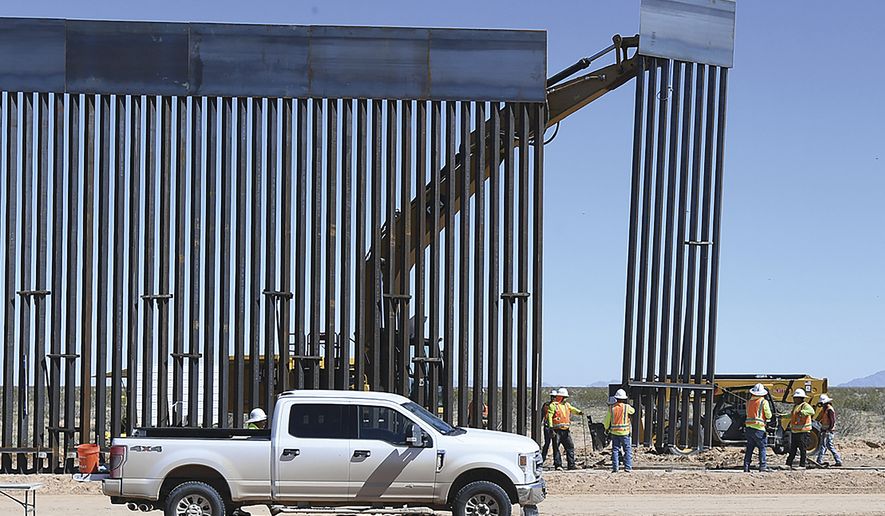If President Trump is allowed to use Defense Department money to complete his border wall, it will be the final step in eliminating the endangered jaguar from U.S. territory, environmentalists said Tuesday in a lawsuit trying to block construction.
The groups said the $7.2 billion Mr. Trump siphoned from Pentagon accounts earlier this year will allow him to build segments of wall in southeastern Arizona and New Mexico, cutting off some of the key corridors used by wildlife that spans Mexico and the U.S.
And with that the dream of reintroducing the jaguar as a viable population here will die, the environmentalists said.
“If constructed, these border wall projects will likely result in the extirpation of endangered jaguars in the United States,” the Center for Biological Diversity, Defenders of Wildlife and the Animal Legal Defense Fund said in their lawsuit.
Their case joins a plethora of others already pending against Mr. Trump’s moves both last year and this year to shift money from Defense Department accounts toward his wall project.
All told, Mr. Trump has shifted about $14 billion toward wall building beyond the amount that Congress has approved.
Many lawsuits contesting the wall construction, including another one last year by the same plaintiffs, are still pending. Lower courts have issued injunctions halting the money transfers as likely illegal, but the Supreme Court put those decisions on hold, allowing construction while the cases are being argued more fully in the lower courts.
This week’s new complaint from the environmental groups also challenges acting Homeland Security Secretary Chad Wolf’s waivers, issued in March, exempting wall construction from environmental laws.
The groups say a number of rare species might suffer from wall construction, including the ocelot, the Sonoran pronghorn, the Quino checkerspot butterfly, the coastal California gnatcatcher, and the jaguar.
The Clinton, Bush and Obama administrations erected fencing along 354 miles of the border, with vehicle barriers covering another 300 miles. Those vehicle barriers are more porous, allowing people — and most animals — easy access.
But the Trump administration is quickly converting many of those miles of vehicle barrier into wall, as well as planning to fence off hundreds of miles of previously unprotected territory.
Customs and Border Protection says the construction is critical to border security, helping stem the flow of migrants and illegal drugs that smugglers try to sneak across.
Acting CBP Commissioner Mark Morgan said earlier this month that the border wall is particularly important amid the coronavirus outbreak because it helps funnel activity to ports of entry where officers can do better screening of what’s coming in to the country
But the environmental groups said the new sections of wall are planned for rugged mountainous terrain, with “high environmental value.”
The money Mr. Trump ordered transferred earlier this year, the groups said, “will be used to build border wall segments within areas of the Tucson Sector and El Paso Sectors containing designated critical habitat for the endangered jaguar, and which would block that species’ key remaining corridors for movement between populations in the United States and Mexico.”
Normally border construction would have to comply with the Endangered Species Act and other environmental laws. But under a section of the Real ID Act, the Homeland Security secretary has power to waive any laws to speed up construction.
The Trump administration has made frequent use of that power, exempting construction from some of the most iconic statutes such as the Safe Drinking Water Act and the Native American Graves Protection and Repatriation Act.
Democrats on Capitol Hill earlier this year accused CBP of digging up American Indian graves in southern Arizona without fully consulting with the Tohono O’odham Nation.
“I’m sure you wouldn’t like it if the federal government blew up your great grandmother’s grave, which is what you’re doing here,” Rep. Debbie Wasserman Schultz said to Mr. Morgan during a hearing.
“I don’t believe that is what I consider we’re doing,” he replied.
Tuesday’s new lawsuit names the Defense Department, the Army Corps of Engineers and Homeland Security.
The Corps referred questions to CBP, which declined to comment because the matter is in litigation.
In other cases, the government has argued the transfers fall within Mr. Trump’s executive powers under the National Emergencies Act, which is the law the president triggered to allow the money to be shifted.
Congress allocated $1.375 billion for wall building in 2019 but Mr. Trump shifted over an additional $6.1 billion in defense money and $601 million in a treasury forfeiture fund. This year Congress again allocated $1.375 billion, and Mr. Trump is shifting an additional $7.2 billion.
When all that money is spent, it will pay for about 731 miles of new wall: 278 miles will fence in parts of the border never previously barricaded, 371 miles will replace existing but outdated fencing or vehicle barriers, and the rest will go toward a secondary wall set behind the main border wall.
Jaguars used to roam from what is now the southwestern U.S. down to Argentina, according to the World Wildlife Fund. Now they number only about 15,000, chiefly in the Amazon basin.
A few have been spotted in the U.S. over the last five years, sparking hopes that the cat might be returning to its ancestral territory.
One, nicknamed “El Jefe,” made headlines when he was caught on video roaming the Santa Rita mountains in southern Arizona. He is believed to have gone back to Mexico in search of a mate, according to local news reports.
Two others have been spotted — though one is now believed dead after photos emerged of a jaguar pelt in 2018. The spot pattern matched the cat nicknamed “Yo’oko,” who’d roamed the Huachuca Mountains.
Another, nicknamed “Sombra,” is believed to have crossed from Mexico into the U.S. in 2016, and has been captured on wildlife cameras in the Chiricahua Mountains.
• Stephen Dinan can be reached at sdinan@washingtontimes.com.




Please read our comment policy before commenting.